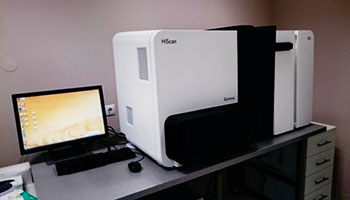Molecular Type 2 Diabetes Biomarker Identified
By LabMedica International staff writers
Posted on 23 Feb 2016
Type 2 diabetes mellitus (DM) is an established risk factor for a wide range of vascular diseases, including ischemic stroke (IS) as well as heart attacks, neuropathy and blindness. Posted on 23 Feb 2016
Type 2 diabetes is a chronic illness characterized by the presence of elevated blood glucose levels and it accounts for between 80% and 90% of diabetes cases and is one of the major cardiovascular risk factors.

Image: The HiScan SQ scanner (Photo courtesy of Illumina).
Scientists at the Hospital del Mar Medical Research Institute (Barcelona, Spain) investigated DNA methylation in the blood samples of a cohort of 355 stroke patients using a state-of-the-art technique that allows them to study more than 450,000 methylation points in the genome. In addition, the study compared the methylation profiles of diabetics and non-diabetics as well as their levels of glycosylated hemoglobin (HbA1c), a biomarker that indicates blood glucose levels over the past three months.
DNA samples were extracted from whole peripheral blood collected in 10 mL EDTA tubes. The Chemagic Magnetic Separation Module I system (Chemagen, Baesweiler, Germany) was used for DNA isolation in one cohort, and the Autopure LS (Qiagen, Hilden, Germany) in another. Genome-wide DNA methylation was assessed using the Illumina HumanMethylation450 Beadchip (Illumina Netherlands; Eindhoven, Netherlands) and the arrays were scanned with the Illumina HiScan SQ scanner.
The study was subsequently replicated in two cohorts from independent populations, with 167 and 645 patients respectively, confirming the relationship between Thioredoxin Interacting Protein (TXNIP) methylation, diabetes and glucose level dysfunction. Methylation of TXNIP was inversely and intensely associated with HbA1c levels specifically related to diabetic patients with poor control of glucose levels. The authors concluded that hypomethylation of the TXNIP gene is related to type 2 DM. The inverse relationship between TXNIP methylation and HbA1c values suggests that TXNIP hypomethylation is a consequence of sustained hyperglycemia levels.
Carolina Soriano-Tárraga, PhD, the lead author of the study said, “The methylation of this gene could be used as an early biomarker of dysfunction in the control of glucose levels. We are currently studying the implications and specific role of this gene in diabetes. In the future it could provide a possible therapeutic target for treating diabetes or controlling glucose concentrations.” The study was published originally online on December 7, 2015, in the journal Human Molecular Genetics.
Related Links:
Hospital del Mar Medical Research Institute
Chemagen
Illumina Netherlands














